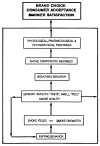Role of cigarette sensory cues in modifying puffing topography
- PMID: 22365895
- PMCID: PMC3371306
- DOI: 10.1016/j.drugalcdep.2012.01.012
Role of cigarette sensory cues in modifying puffing topography
Abstract
Background: Human puffing topography promotes tobacco dependence by ensuring nicotine delivery, but the factors that determine puffing behavior are not well explained by existing models. Chemosensory cues generated by variations in cigarette product design features may serve as conditioned cues to allow the smoker to optimize nicotine delivery by adjusting puffing topography. Internal tobacco industry research documents were reviewed to understand the influence of sensory cues on puffing topography, and to examine how the tobacco industry has designed cigarettes, including modified risk tobacco products (MRTPs), to enhance puffing behavior to optimize nicotine delivery and product acceptability.
Methods: Relevant internal tobacco industry documents were identified using systematic searching with key search terms and phrases, and then snowball sampling method was applied to establish further search terms.
Results: Modern cigarettes are designed by cigarette manufacturers to provide sensory characteristics that not only maintain appeal, but provide cues which inform puffing intensity. Alterations in the chemosensory cues provided in tobacco smoke play an important role in modifying smoking behavior independently of the central effects of nicotine.
Conclusions: An associative learning model is proposed to explain the influence of chemosensory cues on variation in puffing topography. These cues are delivered via tobacco smoke and are moderated by design features and additives used in cigarettes. The implications for regulation of design features of modified risk tobacco products, which may act to promote intensive puffing while lowering risk perceptions, are discussed.
Copyright © 2012 Elsevier Ireland Ltd. All rights reserved.
Conflict of interest statement
KMC has served in the past and continues to serve as a paid expert witness for plaintiffs in litigation against the tobacco industry. No other financial disclosures or conflicts of interest were reported by the authors of this paper.
Figures




References
-
- Ayres CI, Greig CC for British American Tobacco. Report Number RD 1958 Restricted, Smoking Dynamics: Exploratory Studies. 1984 Bates number 102436003/6008. Retrieved June 28 2011, from http://legacy.library.ucsf.edu/tid/xnd92a99.
-
- Ayya N, De Wijk RA, Frijters JE for British American Tobacco. Body and Mouthful Sensations: Background and Proposal for New Studies /486. 1995 Bates number 403100082/0087. Retrieved June 28 2011, from http://legacy.library.ucsf.edu/tid/cdk46b00.
-
- Baldinger B, Hasenfratz M, Battig K for Philip Morris. Effects of Nicotine and Tar Yield on Cigarette Puffing Behavior. 1993 Bates number 2028351066/1082. Retrieved June 28 2011, from http://tobaccodocuments.org/product_design/2028351066-1082.html.
-
- Benowitz NL. National Cancer Institute. Risks Associated with smoking Cigarettes with Low Machine-Measured Yields of Tar and Nicotine. Monograph No. 13. US Department of Health and Human Services; Bethesda MD: 2001. Compensatory smoking of low-yield cigarettes.
Publication types
MeSH terms
Substances
Grants and funding
LinkOut - more resources
Full Text Sources

